A Comprehensive Analysis of Sales and Promotion Schemes of Pizza Club
VerifiedAdded on 2021/04/21
|25
|5346
|30
Report
AI Summary
This report presents an analysis of the sales and promotional schemes employed by The Pizza Club. The study utilizes a mixed research design, combining quantitative and qualitative methods to assess customer perceptions of the restaurant chain. Quantitative data was gathered through a survey questionnaire, exploring customer satisfaction, preferences, and recommendations. Qualitative data was collected via interviews, providing in-depth insights into customer experiences. The findings reveal that while Pizza Club's delivery service is well-regarded, there's room for improvement in in-restaurant services and facilities. The report identifies key strengths and weaknesses, offering recommendations for enhancing promotional strategies and operational efficiency, ultimately aiming to improve the customer experience and address the growing demand for pizza. The analysis includes a thematic analysis of interview transcripts, identifying themes such as value for price, service quality, and outlet facilities.
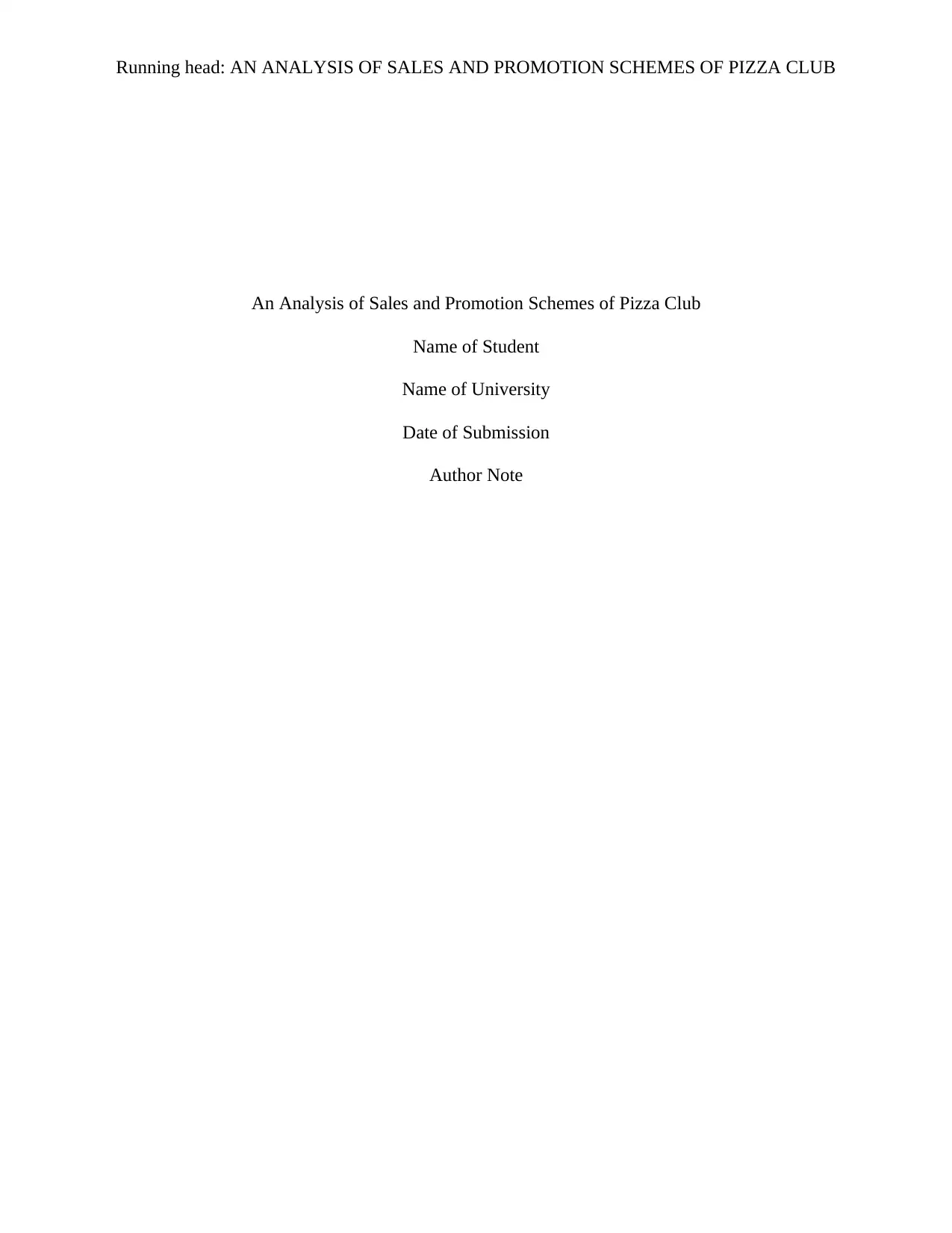
Running head: AN ANALYSIS OF SALES AND PROMOTION SCHEMES OF PIZZA CLUB
An Analysis of Sales and Promotion Schemes of Pizza Club
Name of Student
Name of University
Date of Submission
Author Note
An Analysis of Sales and Promotion Schemes of Pizza Club
Name of Student
Name of University
Date of Submission
Author Note
Paraphrase This Document
Need a fresh take? Get an instant paraphrase of this document with our AI Paraphraser
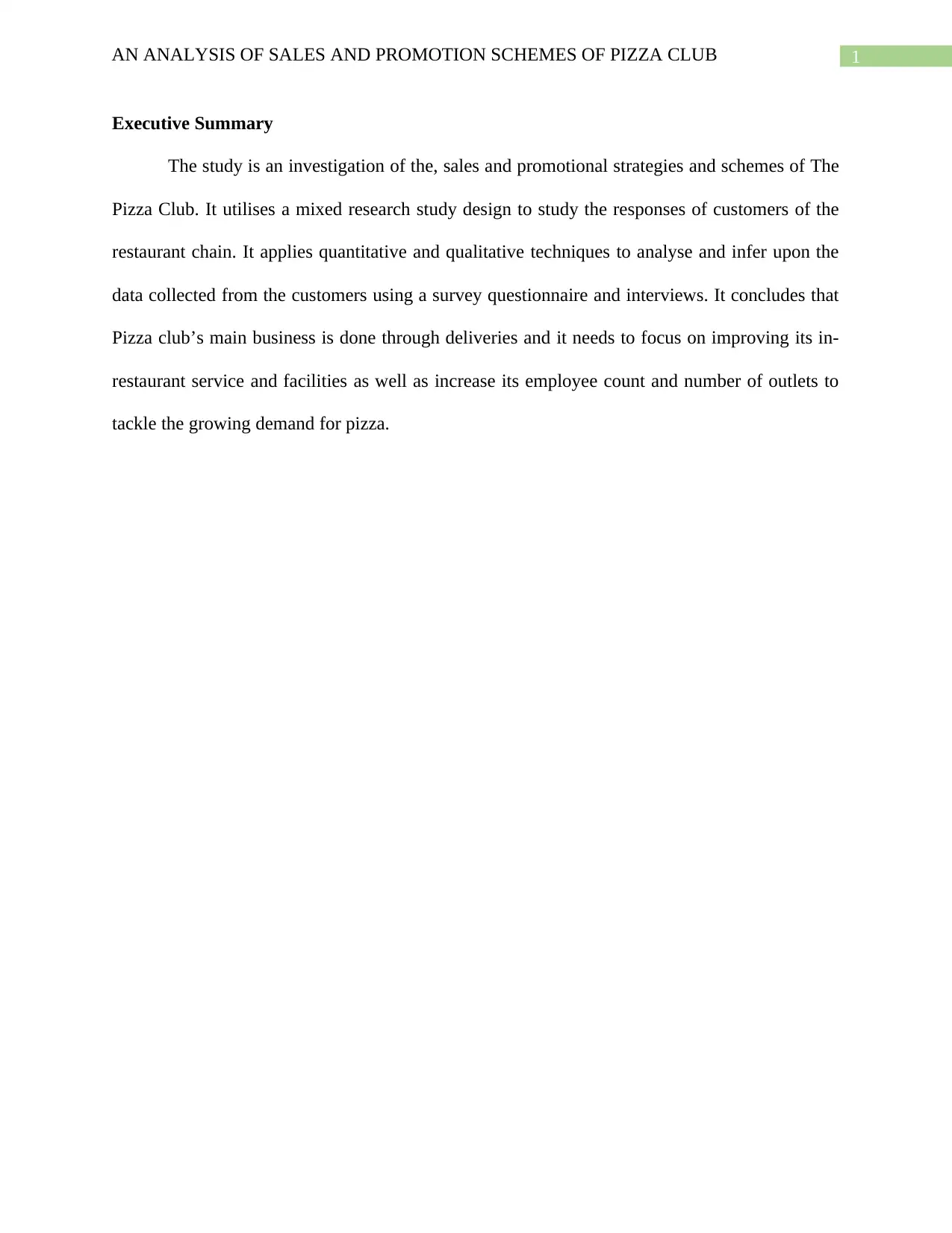
AN ANALYSIS OF SALES AND PROMOTION SCHEMES OF PIZZA CLUB 1
Executive Summary
The study is an investigation of the, sales and promotional strategies and schemes of The
Pizza Club. It utilises a mixed research study design to study the responses of customers of the
restaurant chain. It applies quantitative and qualitative techniques to analyse and infer upon the
data collected from the customers using a survey questionnaire and interviews. It concludes that
Pizza club’s main business is done through deliveries and it needs to focus on improving its in-
restaurant service and facilities as well as increase its employee count and number of outlets to
tackle the growing demand for pizza.
Executive Summary
The study is an investigation of the, sales and promotional strategies and schemes of The
Pizza Club. It utilises a mixed research study design to study the responses of customers of the
restaurant chain. It applies quantitative and qualitative techniques to analyse and infer upon the
data collected from the customers using a survey questionnaire and interviews. It concludes that
Pizza club’s main business is done through deliveries and it needs to focus on improving its in-
restaurant service and facilities as well as increase its employee count and number of outlets to
tackle the growing demand for pizza.
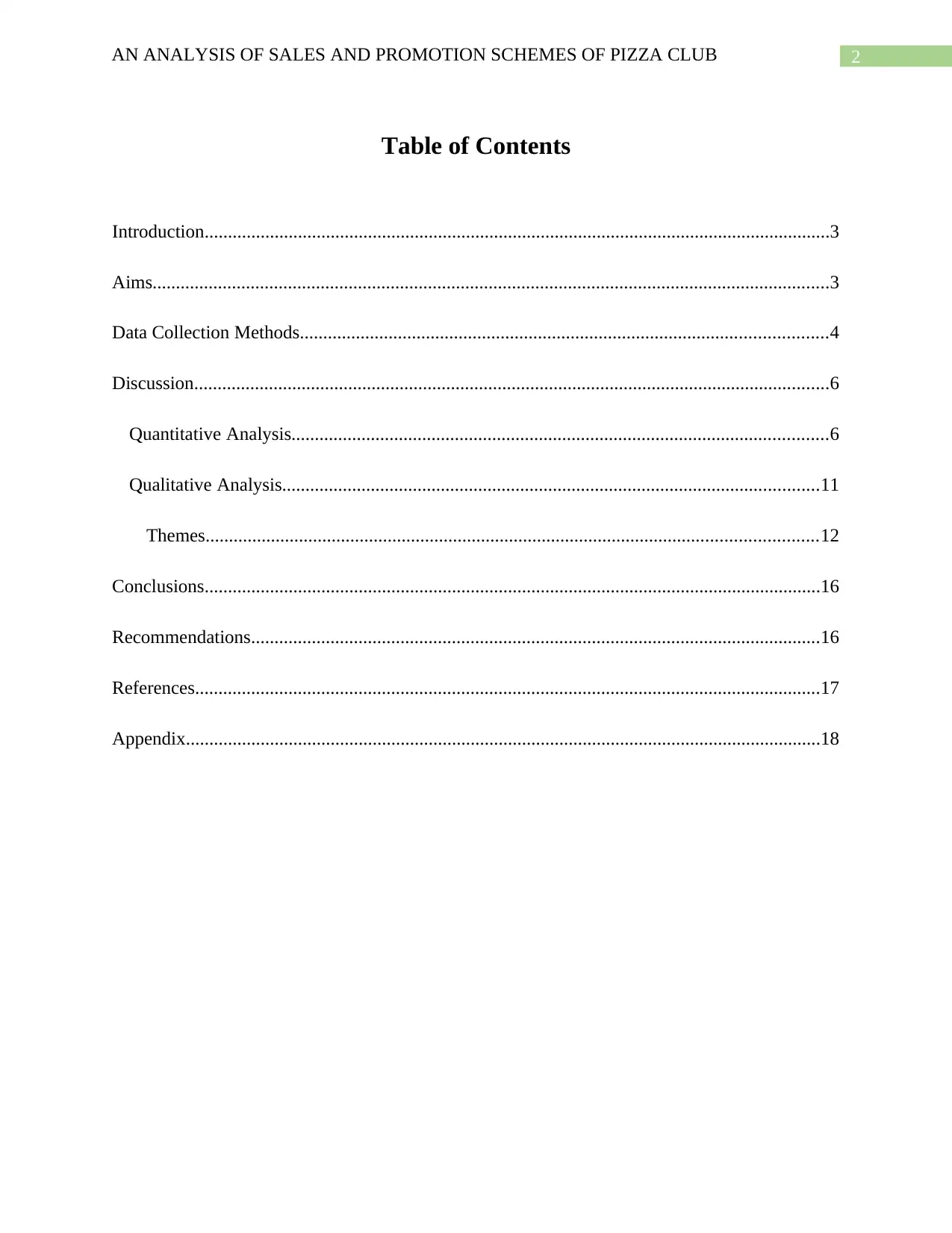
2AN ANALYSIS OF SALES AND PROMOTION SCHEMES OF PIZZA CLUB
Table of Contents
Introduction......................................................................................................................................3
Aims.................................................................................................................................................3
Data Collection Methods.................................................................................................................4
Discussion........................................................................................................................................6
Quantitative Analysis...................................................................................................................6
Qualitative Analysis...................................................................................................................11
Themes...................................................................................................................................12
Conclusions....................................................................................................................................16
Recommendations..........................................................................................................................16
References......................................................................................................................................17
Appendix........................................................................................................................................18
Table of Contents
Introduction......................................................................................................................................3
Aims.................................................................................................................................................3
Data Collection Methods.................................................................................................................4
Discussion........................................................................................................................................6
Quantitative Analysis...................................................................................................................6
Qualitative Analysis...................................................................................................................11
Themes...................................................................................................................................12
Conclusions....................................................................................................................................16
Recommendations..........................................................................................................................16
References......................................................................................................................................17
Appendix........................................................................................................................................18
⊘ This is a preview!⊘
Do you want full access?
Subscribe today to unlock all pages.

Trusted by 1+ million students worldwide
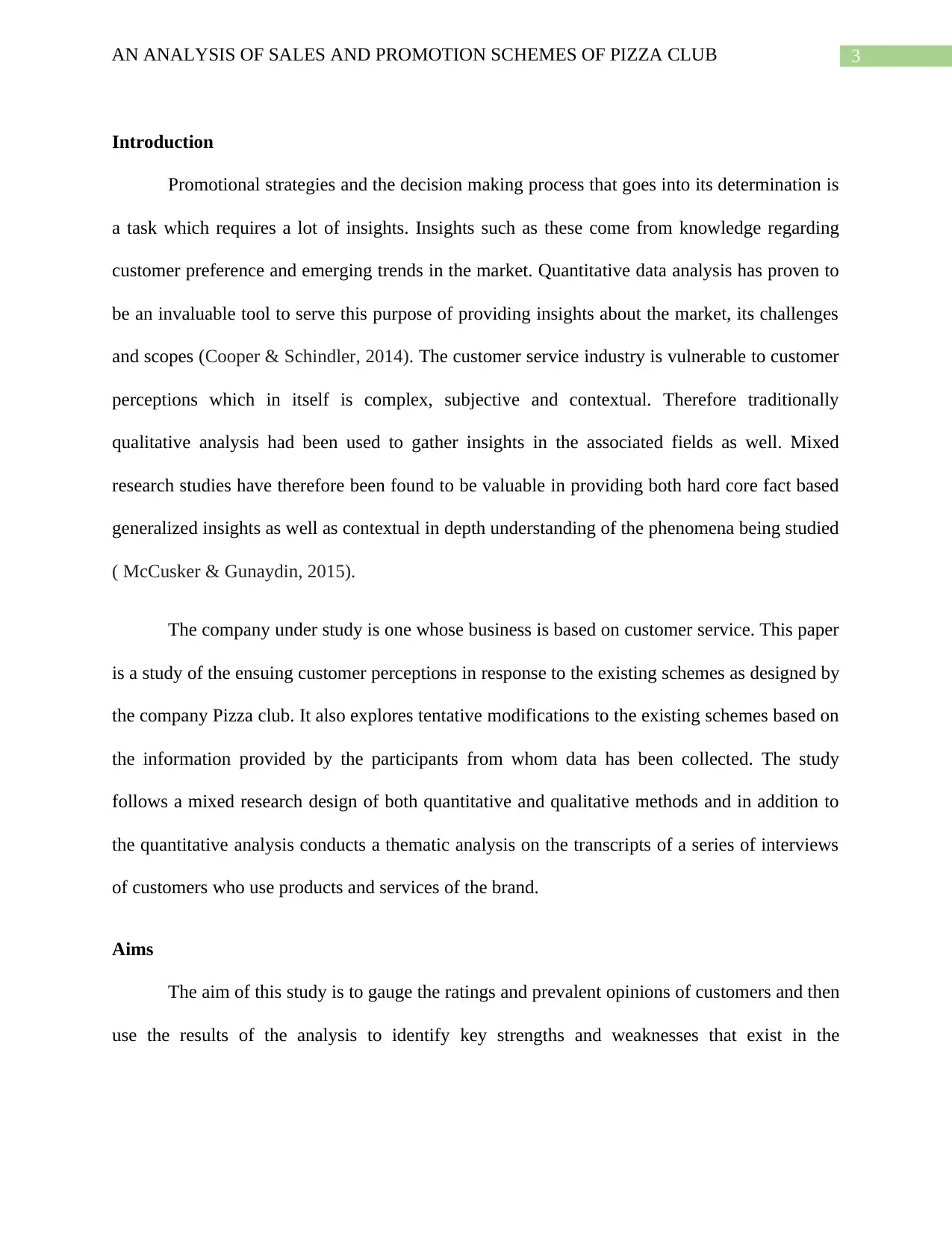
3AN ANALYSIS OF SALES AND PROMOTION SCHEMES OF PIZZA CLUB
Introduction
Promotional strategies and the decision making process that goes into its determination is
a task which requires a lot of insights. Insights such as these come from knowledge regarding
customer preference and emerging trends in the market. Quantitative data analysis has proven to
be an invaluable tool to serve this purpose of providing insights about the market, its challenges
and scopes (Cooper & Schindler, 2014). The customer service industry is vulnerable to customer
perceptions which in itself is complex, subjective and contextual. Therefore traditionally
qualitative analysis had been used to gather insights in the associated fields as well. Mixed
research studies have therefore been found to be valuable in providing both hard core fact based
generalized insights as well as contextual in depth understanding of the phenomena being studied
( McCusker & Gunaydin, 2015).
The company under study is one whose business is based on customer service. This paper
is a study of the ensuing customer perceptions in response to the existing schemes as designed by
the company Pizza club. It also explores tentative modifications to the existing schemes based on
the information provided by the participants from whom data has been collected. The study
follows a mixed research design of both quantitative and qualitative methods and in addition to
the quantitative analysis conducts a thematic analysis on the transcripts of a series of interviews
of customers who use products and services of the brand.
Aims
The aim of this study is to gauge the ratings and prevalent opinions of customers and then
use the results of the analysis to identify key strengths and weaknesses that exist in the
Introduction
Promotional strategies and the decision making process that goes into its determination is
a task which requires a lot of insights. Insights such as these come from knowledge regarding
customer preference and emerging trends in the market. Quantitative data analysis has proven to
be an invaluable tool to serve this purpose of providing insights about the market, its challenges
and scopes (Cooper & Schindler, 2014). The customer service industry is vulnerable to customer
perceptions which in itself is complex, subjective and contextual. Therefore traditionally
qualitative analysis had been used to gather insights in the associated fields as well. Mixed
research studies have therefore been found to be valuable in providing both hard core fact based
generalized insights as well as contextual in depth understanding of the phenomena being studied
( McCusker & Gunaydin, 2015).
The company under study is one whose business is based on customer service. This paper
is a study of the ensuing customer perceptions in response to the existing schemes as designed by
the company Pizza club. It also explores tentative modifications to the existing schemes based on
the information provided by the participants from whom data has been collected. The study
follows a mixed research design of both quantitative and qualitative methods and in addition to
the quantitative analysis conducts a thematic analysis on the transcripts of a series of interviews
of customers who use products and services of the brand.
Aims
The aim of this study is to gauge the ratings and prevalent opinions of customers and then
use the results of the analysis to identify key strengths and weaknesses that exist in the
Paraphrase This Document
Need a fresh take? Get an instant paraphrase of this document with our AI Paraphraser

4AN ANALYSIS OF SALES AND PROMOTION SCHEMES OF PIZZA CLUB
promotional and operational levels of the Pizza Club and provides some recommendations on the
basis of insights gained off of the analysis.
Data Collection Methods
The study used a mixed researched method using both a quantitative approach as well as
a qualitative approach to gather and deliver insights regarding the promotional schemes and sales
of the brand Pizza Club.
The quantitative part of the study was done using data collected through a survey
questionnaire that was designed utilised a set of closed ended questions enquiring about
customer history with respect to the brand, opinions, preferences and recommendations. The
questionnaire and the data collected have been included in the appendix section. The
questionnaire was distributed among the customers and twenty five responses were received on
the basis of which some quantitative measure were computed to get a picture of the scenario
under study (Heeringa, West & Berglund, 2017). The variables upon which data have been
gathered include, “Where have you heard about The Pizza Club?”, which was nominal scale with
“advertisement”, “social media”, “word of mouth” and “others” as categories, “Are you satisfied
with The Pizza Club’s services and products?”, which was ordinal with “not satisfied”, “good”
and “excellent” as ordered categories, “Are you satisfied with the different deals of The Pizza
Club?”, which was also ordinal with four ordered categories, namely, “ dissatisfied”, “average”,
“satisfied” and “very satisfied”, “How would you rate the quality of The Pizza club products?”,
which was ordinal with four ordinal levels, namely, “not good”, “good”, “very good” and
promotional and operational levels of the Pizza Club and provides some recommendations on the
basis of insights gained off of the analysis.
Data Collection Methods
The study used a mixed researched method using both a quantitative approach as well as
a qualitative approach to gather and deliver insights regarding the promotional schemes and sales
of the brand Pizza Club.
The quantitative part of the study was done using data collected through a survey
questionnaire that was designed utilised a set of closed ended questions enquiring about
customer history with respect to the brand, opinions, preferences and recommendations. The
questionnaire and the data collected have been included in the appendix section. The
questionnaire was distributed among the customers and twenty five responses were received on
the basis of which some quantitative measure were computed to get a picture of the scenario
under study (Heeringa, West & Berglund, 2017). The variables upon which data have been
gathered include, “Where have you heard about The Pizza Club?”, which was nominal scale with
“advertisement”, “social media”, “word of mouth” and “others” as categories, “Are you satisfied
with The Pizza Club’s services and products?”, which was ordinal with “not satisfied”, “good”
and “excellent” as ordered categories, “Are you satisfied with the different deals of The Pizza
Club?”, which was also ordinal with four ordered categories, namely, “ dissatisfied”, “average”,
“satisfied” and “very satisfied”, “How would you rate the quality of The Pizza club products?”,
which was ordinal with four ordinal levels, namely, “not good”, “good”, “very good” and
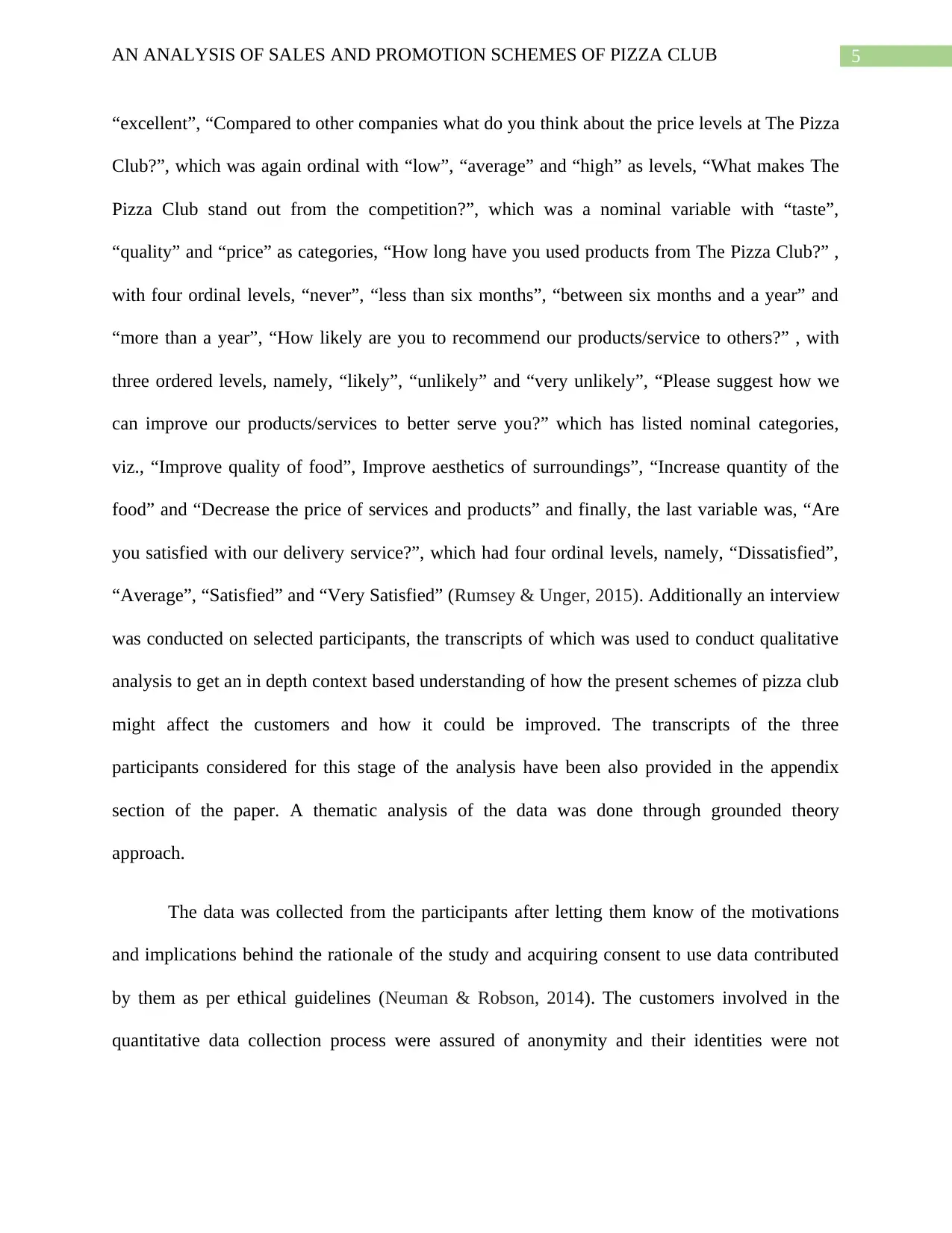
5AN ANALYSIS OF SALES AND PROMOTION SCHEMES OF PIZZA CLUB
“excellent”, “Compared to other companies what do you think about the price levels at The Pizza
Club?”, which was again ordinal with “low”, “average” and “high” as levels, “What makes The
Pizza Club stand out from the competition?”, which was a nominal variable with “taste”,
“quality” and “price” as categories, “How long have you used products from The Pizza Club?” ,
with four ordinal levels, “never”, “less than six months”, “between six months and a year” and
“more than a year”, “How likely are you to recommend our products/service to others?” , with
three ordered levels, namely, “likely”, “unlikely” and “very unlikely”, “Please suggest how we
can improve our products/services to better serve you?” which has listed nominal categories,
viz., “Improve quality of food”, Improve aesthetics of surroundings”, “Increase quantity of the
food” and “Decrease the price of services and products” and finally, the last variable was, “Are
you satisfied with our delivery service?”, which had four ordinal levels, namely, “Dissatisfied”,
“Average”, “Satisfied” and “Very Satisfied” (Rumsey & Unger, 2015). Additionally an interview
was conducted on selected participants, the transcripts of which was used to conduct qualitative
analysis to get an in depth context based understanding of how the present schemes of pizza club
might affect the customers and how it could be improved. The transcripts of the three
participants considered for this stage of the analysis have been also provided in the appendix
section of the paper. A thematic analysis of the data was done through grounded theory
approach.
The data was collected from the participants after letting them know of the motivations
and implications behind the rationale of the study and acquiring consent to use data contributed
by them as per ethical guidelines (Neuman & Robson, 2014). The customers involved in the
quantitative data collection process were assured of anonymity and their identities were not
“excellent”, “Compared to other companies what do you think about the price levels at The Pizza
Club?”, which was again ordinal with “low”, “average” and “high” as levels, “What makes The
Pizza Club stand out from the competition?”, which was a nominal variable with “taste”,
“quality” and “price” as categories, “How long have you used products from The Pizza Club?” ,
with four ordinal levels, “never”, “less than six months”, “between six months and a year” and
“more than a year”, “How likely are you to recommend our products/service to others?” , with
three ordered levels, namely, “likely”, “unlikely” and “very unlikely”, “Please suggest how we
can improve our products/services to better serve you?” which has listed nominal categories,
viz., “Improve quality of food”, Improve aesthetics of surroundings”, “Increase quantity of the
food” and “Decrease the price of services and products” and finally, the last variable was, “Are
you satisfied with our delivery service?”, which had four ordinal levels, namely, “Dissatisfied”,
“Average”, “Satisfied” and “Very Satisfied” (Rumsey & Unger, 2015). Additionally an interview
was conducted on selected participants, the transcripts of which was used to conduct qualitative
analysis to get an in depth context based understanding of how the present schemes of pizza club
might affect the customers and how it could be improved. The transcripts of the three
participants considered for this stage of the analysis have been also provided in the appendix
section of the paper. A thematic analysis of the data was done through grounded theory
approach.
The data was collected from the participants after letting them know of the motivations
and implications behind the rationale of the study and acquiring consent to use data contributed
by them as per ethical guidelines (Neuman & Robson, 2014). The customers involved in the
quantitative data collection process were assured of anonymity and their identities were not
⊘ This is a preview!⊘
Do you want full access?
Subscribe today to unlock all pages.

Trusted by 1+ million students worldwide
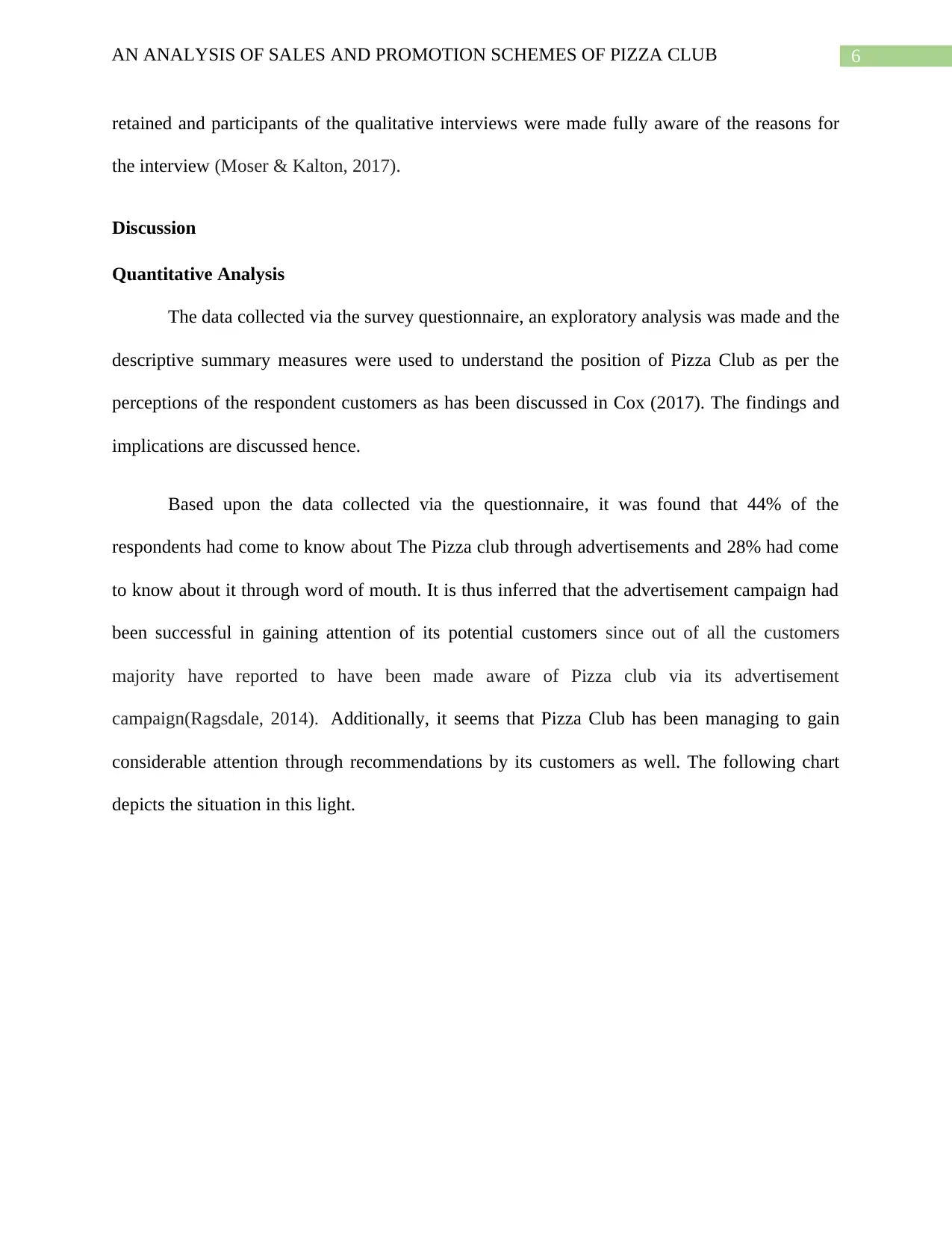
6AN ANALYSIS OF SALES AND PROMOTION SCHEMES OF PIZZA CLUB
retained and participants of the qualitative interviews were made fully aware of the reasons for
the interview (Moser & Kalton, 2017).
Discussion
Quantitative Analysis
The data collected via the survey questionnaire, an exploratory analysis was made and the
descriptive summary measures were used to understand the position of Pizza Club as per the
perceptions of the respondent customers as has been discussed in Cox (2017). The findings and
implications are discussed hence.
Based upon the data collected via the questionnaire, it was found that 44% of the
respondents had come to know about The Pizza club through advertisements and 28% had come
to know about it through word of mouth. It is thus inferred that the advertisement campaign had
been successful in gaining attention of its potential customers since out of all the customers
majority have reported to have been made aware of Pizza club via its advertisement
campaign(Ragsdale, 2014). Additionally, it seems that Pizza Club has been managing to gain
considerable attention through recommendations by its customers as well. The following chart
depicts the situation in this light.
retained and participants of the qualitative interviews were made fully aware of the reasons for
the interview (Moser & Kalton, 2017).
Discussion
Quantitative Analysis
The data collected via the survey questionnaire, an exploratory analysis was made and the
descriptive summary measures were used to understand the position of Pizza Club as per the
perceptions of the respondent customers as has been discussed in Cox (2017). The findings and
implications are discussed hence.
Based upon the data collected via the questionnaire, it was found that 44% of the
respondents had come to know about The Pizza club through advertisements and 28% had come
to know about it through word of mouth. It is thus inferred that the advertisement campaign had
been successful in gaining attention of its potential customers since out of all the customers
majority have reported to have been made aware of Pizza club via its advertisement
campaign(Ragsdale, 2014). Additionally, it seems that Pizza Club has been managing to gain
considerable attention through recommendations by its customers as well. The following chart
depicts the situation in this light.
Paraphrase This Document
Need a fresh take? Get an instant paraphrase of this document with our AI Paraphraser

7AN ANALYSIS OF SALES AND PROMOTION SCHEMES OF PIZZA CLUB
44%
12%
16%
28%
Where have you heard about pizza club?
Advertisement
Others
Social media
Word of Mouth
Figure 1
The performance of the business in regards to customer satisfaction was found to be
good, with 20% of the respondents of the survey rating their satisfaction with Pizza Club’s
services and products as “Excellent”, 68% rating it as “Good” and only 12% rating it as “Not
Satisfactory”. The following chart ,computed in MS Excel, graphically shows the situation.
20%
68%
12%
Are you satisfied with pizza club services and
products?
Excellent
Good
Not satisfied
44%
12%
16%
28%
Where have you heard about pizza club?
Advertisement
Others
Social media
Word of Mouth
Figure 1
The performance of the business in regards to customer satisfaction was found to be
good, with 20% of the respondents of the survey rating their satisfaction with Pizza Club’s
services and products as “Excellent”, 68% rating it as “Good” and only 12% rating it as “Not
Satisfactory”. The following chart ,computed in MS Excel, graphically shows the situation.
20%
68%
12%
Are you satisfied with pizza club services and
products?
Excellent
Good
Not satisfied

8AN ANALYSIS OF SALES AND PROMOTION SCHEMES OF PIZZA CLUB
Figure 2
Only 8% out of all the respondents of the survey questionnaire reported to be dissatisfied
with the different existing deals by Pizza Club. It is thus suggested that pizza club has been
performing well in this aspect of its marketing scheme.
48%
8%
32%
12%
Are you satisfied with the different deals of pizza
club?
Average
Dissatisfied
Satisfied
Very satisfied
Figure 4
Quality wise The Pizza Club has been observed to be rated positively by the respondents
with 8% rating is as excellent, 28% rating it as very good and 56% as just good and only 8% as
not good.
Figure 2
Only 8% out of all the respondents of the survey questionnaire reported to be dissatisfied
with the different existing deals by Pizza Club. It is thus suggested that pizza club has been
performing well in this aspect of its marketing scheme.
48%
8%
32%
12%
Are you satisfied with the different deals of pizza
club?
Average
Dissatisfied
Satisfied
Very satisfied
Figure 4
Quality wise The Pizza Club has been observed to be rated positively by the respondents
with 8% rating is as excellent, 28% rating it as very good and 56% as just good and only 8% as
not good.
⊘ This is a preview!⊘
Do you want full access?
Subscribe today to unlock all pages.

Trusted by 1+ million students worldwide
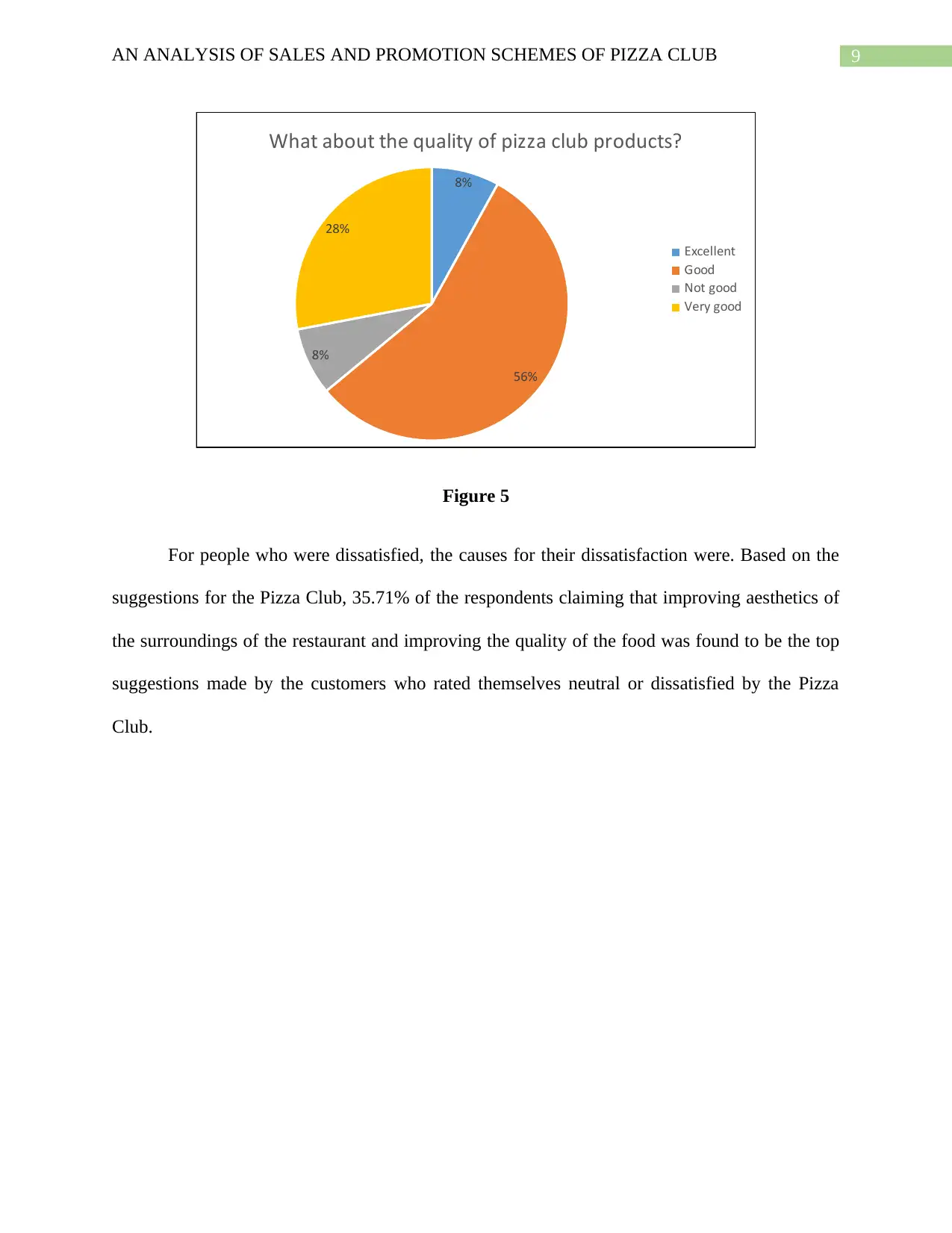
9AN ANALYSIS OF SALES AND PROMOTION SCHEMES OF PIZZA CLUB
8%
56%
8%
28%
What about the quality of pizza club products?
Excellent
Good
Not good
Very good
Figure 5
For people who were dissatisfied, the causes for their dissatisfaction were. Based on the
suggestions for the Pizza Club, 35.71% of the respondents claiming that improving aesthetics of
the surroundings of the restaurant and improving the quality of the food was found to be the top
suggestions made by the customers who rated themselves neutral or dissatisfied by the Pizza
Club.
8%
56%
8%
28%
What about the quality of pizza club products?
Excellent
Good
Not good
Very good
Figure 5
For people who were dissatisfied, the causes for their dissatisfaction were. Based on the
suggestions for the Pizza Club, 35.71% of the respondents claiming that improving aesthetics of
the surroundings of the restaurant and improving the quality of the food was found to be the top
suggestions made by the customers who rated themselves neutral or dissatisfied by the Pizza
Club.
Paraphrase This Document
Need a fresh take? Get an instant paraphrase of this document with our AI Paraphraser
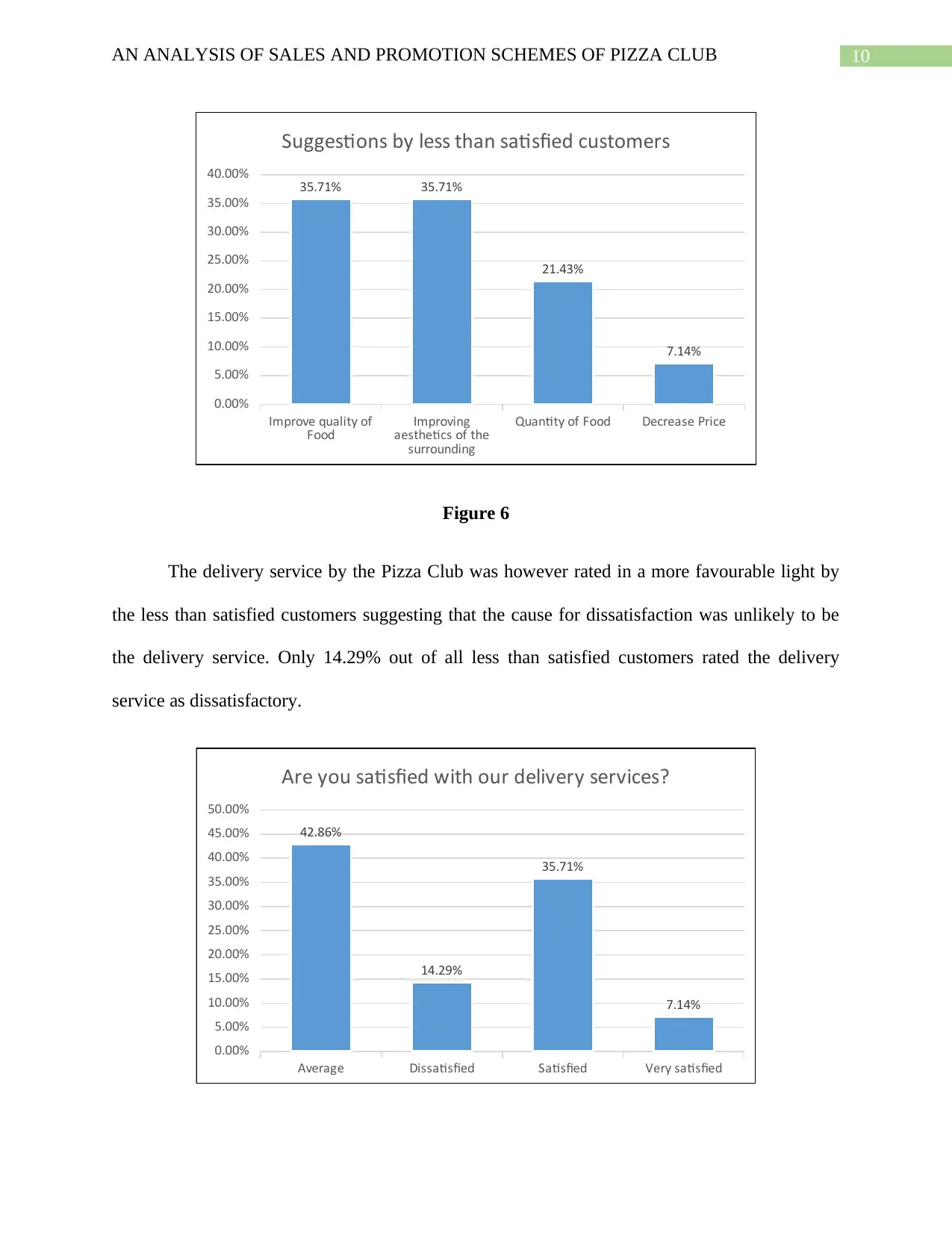
10AN ANALYSIS OF SALES AND PROMOTION SCHEMES OF PIZZA CLUB
Improve quality of
Food Improving
aesthetics of the
surrounding
Quantity of Food Decrease Price
0.00%
5.00%
10.00%
15.00%
20.00%
25.00%
30.00%
35.00%
40.00% 35.71% 35.71%
21.43%
7.14%
Suggestions by less than satisfied customers
Figure 6
The delivery service by the Pizza Club was however rated in a more favourable light by
the less than satisfied customers suggesting that the cause for dissatisfaction was unlikely to be
the delivery service. Only 14.29% out of all less than satisfied customers rated the delivery
service as dissatisfactory.
Average Dissatisfied Satisfied Very satisfied
0.00%
5.00%
10.00%
15.00%
20.00%
25.00%
30.00%
35.00%
40.00%
45.00%
50.00%
42.86%
14.29%
35.71%
7.14%
Are you satisfied with our delivery services?
Improve quality of
Food Improving
aesthetics of the
surrounding
Quantity of Food Decrease Price
0.00%
5.00%
10.00%
15.00%
20.00%
25.00%
30.00%
35.00%
40.00% 35.71% 35.71%
21.43%
7.14%
Suggestions by less than satisfied customers
Figure 6
The delivery service by the Pizza Club was however rated in a more favourable light by
the less than satisfied customers suggesting that the cause for dissatisfaction was unlikely to be
the delivery service. Only 14.29% out of all less than satisfied customers rated the delivery
service as dissatisfactory.
Average Dissatisfied Satisfied Very satisfied
0.00%
5.00%
10.00%
15.00%
20.00%
25.00%
30.00%
35.00%
40.00%
45.00%
50.00%
42.86%
14.29%
35.71%
7.14%
Are you satisfied with our delivery services?

11AN ANALYSIS OF SALES AND PROMOTION SCHEMES OF PIZZA CLUB
Figure 7
Again considering the opinions of the customers participating in the survey who reported
that they were satisfied or more than satisfied, it was found that Price was rated as the foremost
reason that they feel the Pizza Club has an edge over its competitors with 54.55% of the
respondents claiming so, followed by taste of its food with 27.27% of votes and then quality with
18.18%.
Price Quality Taste
0.00%
10.00%
20.00%
30.00%
40.00%
50.00%
60.00% 54.55%
18.18%
27.27%
What makes us stand out from the competition?
Figure 8
Qualitative Analysis
Three customers of the Pizza club were chosen to be a part of an interview to understand
in depth their feelings about the chain of restaurants regarding their experience as a customer of
the Pizza club so far. Following the directives for identifying the relevant topics in thematic
analysis as per Glaser(2016), the participants were asked a series of open ended questions
regarding how many times they had visited a pizza club restaurant before and with whom and
their preferences in terms of the restaurant’s services, products and recommendations.
Figure 7
Again considering the opinions of the customers participating in the survey who reported
that they were satisfied or more than satisfied, it was found that Price was rated as the foremost
reason that they feel the Pizza Club has an edge over its competitors with 54.55% of the
respondents claiming so, followed by taste of its food with 27.27% of votes and then quality with
18.18%.
Price Quality Taste
0.00%
10.00%
20.00%
30.00%
40.00%
50.00%
60.00% 54.55%
18.18%
27.27%
What makes us stand out from the competition?
Figure 8
Qualitative Analysis
Three customers of the Pizza club were chosen to be a part of an interview to understand
in depth their feelings about the chain of restaurants regarding their experience as a customer of
the Pizza club so far. Following the directives for identifying the relevant topics in thematic
analysis as per Glaser(2016), the participants were asked a series of open ended questions
regarding how many times they had visited a pizza club restaurant before and with whom and
their preferences in terms of the restaurant’s services, products and recommendations.
⊘ This is a preview!⊘
Do you want full access?
Subscribe today to unlock all pages.

Trusted by 1+ million students worldwide
1 out of 25
Related Documents
Your All-in-One AI-Powered Toolkit for Academic Success.
+13062052269
info@desklib.com
Available 24*7 on WhatsApp / Email
![[object Object]](/_next/static/media/star-bottom.7253800d.svg)
Unlock your academic potential
Copyright © 2020–2025 A2Z Services. All Rights Reserved. Developed and managed by ZUCOL.





